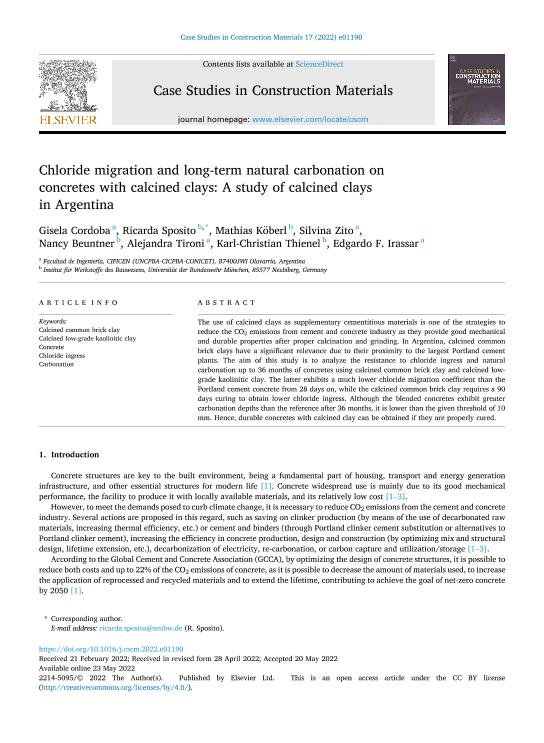Artículo
Chloride migration and long-term natural carbonation on concretes with calcined clays: A study of calcined clays in Argentina
Cordoba, Gisela Paola ; Sposito, Ricarda; Köberl, Mathias; Zito, Silvina Vanessa
; Sposito, Ricarda; Köberl, Mathias; Zito, Silvina Vanessa ; Beuntner, Nancy; Tironi, Alejandra
; Beuntner, Nancy; Tironi, Alejandra ; Thienel, Karl Christian; Irassar, Edgardo Fabián
; Thienel, Karl Christian; Irassar, Edgardo Fabián
 ; Sposito, Ricarda; Köberl, Mathias; Zito, Silvina Vanessa
; Sposito, Ricarda; Köberl, Mathias; Zito, Silvina Vanessa ; Beuntner, Nancy; Tironi, Alejandra
; Beuntner, Nancy; Tironi, Alejandra ; Thienel, Karl Christian; Irassar, Edgardo Fabián
; Thienel, Karl Christian; Irassar, Edgardo Fabián
Fecha de publicación:
05/2022
Editorial:
Elsevier
Revista:
Case Studies in Construction Materials
ISSN:
2214-5095
Idioma:
Inglés
Tipo de recurso:
Artículo publicado
Clasificación temática:
Resumen
The use of calcined clays as supplementary cementitious materials is one of the strategies to reduce the CO2 emissions from cement and concrete industry as they provide good mechanical and durable properties after proper calcination and grinding. In Argentina, calcined common brick clays have a significant relevance due to their proximity to the largest Portland cement plants. The aim of this study is to analyze the resistance to chloride ingress and natural carbonation up to 36 months of concretes using calcined common brick clay and calcined low-grade kaolinitic clay. The latter exhibits a much lower chloride migration coefficient than the Portland cement concrete from 28 days on, while the calcined common brick clay requires a 90 days curing to obtain lower chloride ingress. Although the blended concretes exhibit greater carbonation depths than the reference after 36 months, it is lower than the given threshold of 10 mm. Hence, durable concretes with calcined clay can be obtained if they are properly cured.
Archivos asociados
Licencia
Identificadores
Colecciones
Articulos(CIFICEN)
Articulos de CENTRO DE INV. EN FISICA E INGENIERIA DEL CENTRO DE LA PCIA. DE BS. AS.
Articulos de CENTRO DE INV. EN FISICA E INGENIERIA DEL CENTRO DE LA PCIA. DE BS. AS.
Citación
Cordoba, Gisela Paola; Sposito, Ricarda; Köberl, Mathias; Zito, Silvina Vanessa; Beuntner, Nancy; et al.; Chloride migration and long-term natural carbonation on concretes with calcined clays: A study of calcined clays in Argentina; Elsevier; Case Studies in Construction Materials; 17; 5-2022; 1-12
Compartir
Altmétricas



